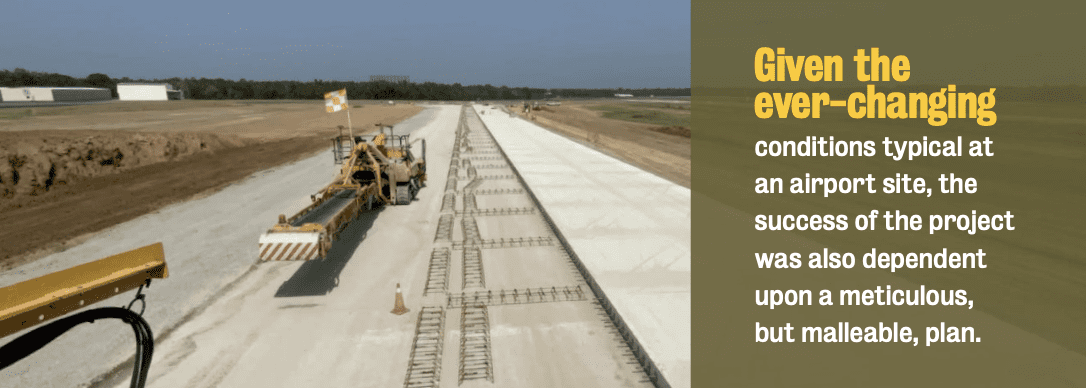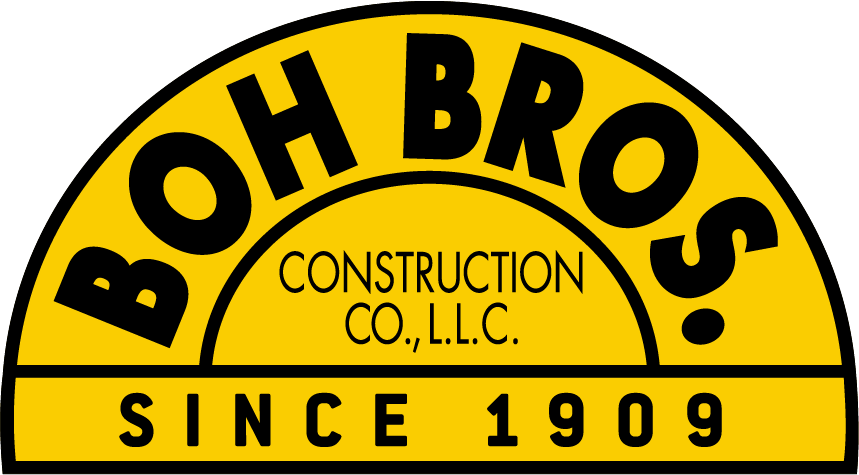
Delays, breakdowns, and a technical malfunction could have easily derailed a major paving job like the Lafayette Regional Airport’s Taxiway F, Phase 3 project. In this case, however, the Boh Bros. Construction team achieved stringent FAA-mandated grade/smoothness tolerances, delivering the project on time and on budget. The Lafayette Airport job entailed connecting two existing taxiways to its newly constructed terminal. From October through November 2023, the Boh team paved 12 inches of concrete over 20,500 square yards; once completed, they then sealed the concrete joints following the placement of asphalt around the perimeter.
To reduce the probability of traffic disruptions and weather-related issues, the entirety of the paving operation was performed at night. Communication proved critical throughout the process. “When we’d get to a stopping point, we would quickly come up with the game plan for the next night,” says Carey Capdeville, construction manager for Boh’s Aviation Paving Group. “That way, when the project team walked in the office the next morning, they would get that information and ensure everything was ready for the next evening.”
Unlike other construction projects, such as roads and bridges, airports require a different approach. Airports are scattered across the country and present unique challenges, specifically as it relates to FAA rules and regulations. Therefore, the Boh Aviation Paving Group operates somewhat differently than the other departments. With 80 percent of its work taking place outside the greater New Orleans region, the Team is accustomed to addressing the inherent challenges associated with being an out-of-town contractor. Paving Lafayette Regional Airport’s Taxiway proved no different. “We bid these projects on paper, and we come up with a pour plan based upon what we see on paper and a job visit,” Capdeville says. “Once you get to the project, however, things change. Paper is never the same as real life.
“Our initial pour plan had to be changed once we got eyes on the job and saw the access points in and out of the job were different than we’d thought,” he adds. The original plan called for four large pours of 1,000 yards of concrete each, with two additional smaller pours, but due to unforeseen circumstances the number of pours ballooned to 10.
Andrew Hendrickson, project manager, emphasized consistency as the key in achieving the project’s goals, most importantly a stringent FAA-mandated ½-inch maximum pavement variation requirement. “Our team worked to ensure we had properly mixed concrete that was correctly placed, cured, and sawed,” Hendrickson says.

Plan Meets Reality
A paving job is only as good as its base, so Boh managers visited the site prior to mobilization to monitor the prep work. “Everything we do is based upon the quality of the surface that we’re working on,” Hendrickson says.
Given the ever-changing conditions typical at an airport site, the success of the project also relied upon a meticulous, but malleable, plan. “We did a ton of planning at the front-end,” Hendrickson says, “but things are constantly changing. You can plan as much as you want, but there are so many factors that can impact that.”
Working in an airport created other potential risks to the pavement sequence, as truck drivers had to get escorted in and out of the gate.
Each time a challenge emerged, the Boh team would halt paving, install a “header,” or a fixed form installed at a transverse joint, and adjust the pave plan. “We would just roll with, adapt, and change our sequence,” Hendrickson says. “That’s just what we do.”
Capdeville and John Schlumbrecht, paving superintendent, would frequently revise routes and access points for trucks, equipment, and crew in response to changing conditions at the site. “We’d often make revisions on the same day since truck access would change depending upon the airport’s needs,” Capdeville says.
At the start of each day, Schlumbrecht would go over the paving plan with the rest of the team. Boh’s New Orleans-based paving crew relocated to Lafayette for the duration of the paving operation, allowing them to leave and come back when needed. “Every project, we have the same group of guys,” Schlumbrecht says. “Communication and their familiarity with each other were key. They’ve worked together nonstop, and that helps.”
“As a result, they had the materials available to set headers and had everything ready to go,” he adds. “When something happened, we’d just set a header, get off it and clean up.”
Quality was always top of mind. A third-party testing company would sample the aggregate twice a day, and the Boh team would make minor tweaks to the mix design based on the sample. “If it had more fines in it one day, we’d tweak the mix to accommodate that, or vice versa,” Hendrickson says.
The team’s Leica iCON 3D system helped ensure that grade/smoothness requirements were achieved, “and everything we did was built off of that,” says Jason Aubin, group manager – aviation paving. “Our team successfully paved the whole taxiway and its connectors with zero surface corrections to meet specification tolerances on the project.”

Success in the End
Ultimately, the ability and resilience of the Boh Team’s seasoned paving crew to stop, regroup, and resequence the concrete paving job helped to deliver the Lafayette Regional Airport’s Taxiway project on budget and on schedule despite obstacles.
It was a fact not lost on the owner. Steven Picou, the airport’s executive director, would visit the site every morning between 5:30 to 6 am during production, regardless of whether the Boh team poured or not.
“I think this is one of those rare construction projects where all the team members (owner, design team and construction implementation team) worked well together to have a highly successful project,” says Sean Brennan, senior aviation engineer with RS&H in Austin, the project’s engineer. “Ultimately, there were very few surprises, and most difficulties were overcome through collaboration between all parties.
“I’ve been in construction for over 30 years and there have only been a few construction projects that have moved along this smoothly.”

Recent Comments